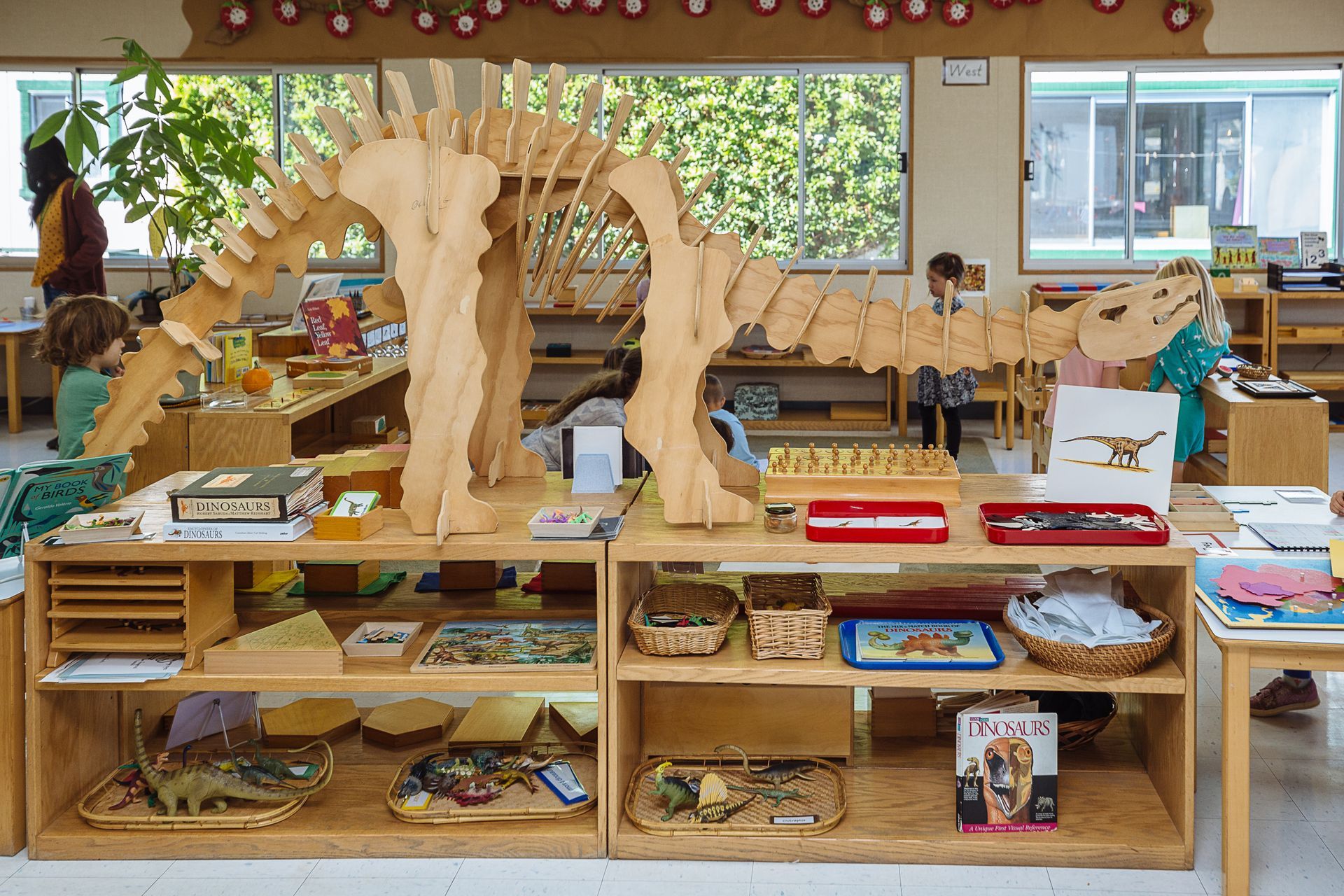What Makes a Montessori Classroom Different?

Curious to know what sets Montessori apart from other schools of learning, not just in pre-school but in the elementary years as well? Read on to learn five unique characteristics of an Montessori classroom and its relevancy below.
Children collaborate and socialize with peers of different ages.
Montessori classrooms are grouped in multi-age, three-year groupings, not year-by-year. This means that learning happens naturally around a child’s development, not arbitrarily by their age. No two children are expected to learn at the same pace. The younger children are motivated to progress because they see firsthand what advanced work the older children get to do. Meanwhile, the older children enjoy helping their younger peers, reinforcing what they’ve learned while taking on meaningful leadership roles.
As children become increasingly social, Montessori Elementary classrooms are grouped for ages 6-9, then 9-12. These mixed-age classrooms mirror eventual work environments, where collaboration in the real world is never “same age,” but similarly spans varying levels of experience.
Children will not be told what to learn by a teacher; they will be shown how to learn.
The Montessori teacher’s role is different than a traditionally trained teacher. A Montessori educator does not command the front of the room to direct what the children will learn. Instead, the invitation to learn is sparked by the meticulously prepared setup that activates self-directed exploration. The teacher protects long, open-ended work periods where the children are free to choose their areas of interest. Never anchored by a teacher’s desk, which does not exist in a Montessori classroom, the teacher moves as the children do, always observing, engaging and supporting each child’s interests, strengths and struggles. A Montessori teacher receives specialized training and is an expert at teaching by showing, not teaching by telling.
In the early years, teachers provide individualized support for the child who is trying to understand and categorize their surroundings. From Elementary on, when children become more interested in deeper reasoning, small-group and project-based learning unfold. However, group learning with a Montessori teacher is never assigned from the top down. Instead, older students have the freedom to initiate and plan for their own projects, forming peer groups naturally and honing lifelong executive functioning skills.
Children are given trust and autonomy for greater independence within a deeply collaborative, community-oriented framework.
Most people associate a Montessori classroom with independence, but this independence is in the context of community. The child does not work alone in silence, but freely interacts as a valued part of the classroom “community.” This is partly why a working Montessori classroom is known for having a “busy hum,”–– never too quiet, never too loud. It is harmonious, where children are given both freedom and limits.
Under age 6, this community framework is nurtured with
Practical Life and
Grace and Courtesy lessons. Toddlers and preschoolers collectively care for their classrooms and each other. They participate in dusting the shelves, wiping the tables, watering the plants, and they put materials away when they are done so that the next child can use them, too. It brings dignity while showing the child how they directly impact their surroundings and those around them. It also equates learning with joy because children in Montessori classrooms are not relegated to a world of “don’t touch,” or “pretend.” Instead, they are empowered to contribute without fear of making a mistake. This inclusivity empowers them to trust their own capability and desire to learn.
Children gain hands-on experience using Montessori materials that have been carefully sequenced for developmentally appropriate progression.
A child will not learn by rote memorization in a Montessori classroom. Instead, Montessori classrooms are acutely focused on hands-on, experience-based learning where children learn by doing. This is true for all areas of the curriculum, from language to cultural studies to math. The Montessori learning materials are designed to engage the child’s hands, creating lasting, concrete impressions of abstract concepts that promote retention of knowledge, not just acquisition.
Hands-on learning in a Montessori classroom goes beyond busying the child’s hands, but it also aims to protect the child’s own motivation by using materials that are self-correcting. When a material is self-correcting, an adult is not required to interrupt the child’s experience because the material has a built-in control of error––like a puzzle that only fits together a certain way––making it obvious when the child needs to troubleshoot. Therefore, the Montessori student learns through experience, not just because of having physical materials to use, but because the child is also free from unnecessary supervision during those critical moments of concentration and problem-solving.
Children will build lifelong social and emotional skills that are uniquely emphasized alongside academics.
Social and emotional development is treated as a lifelong journey, and teachers become significant role models in the classroom for this aspect of development. Maria Montessori believed that true discipline came from within, not from an authoritative source. To respect this developing moral compass, Montessori teachers never use quick-fix, extrinsically motivated tactics like bribery, reward charts, or punishments. Instead, a child receives logical and respectful guidance on what is expected, good, fair, and right.
All behaviors are received as a means of communication, and teachers work with children to identify the root cause of behaviors deemed undesirable so that the child can return to a peaceful state. Teachers model respect by treating each child as a whole person, never as an inferior who must blindly obey. Children do not learn to behave because an adult “said so,” but because they have seen and experienced what feels right within a safe, age-appropriate framework. They have also been given concrete tools to identify, process and cope with varying emotions that, as humans, we all face for the rest of our lives.
As the student advances into adolescent Montessori classrooms, this all-encompassing social and emotional support continues. Collectively, these five aspects nurture one overarching goal: help children realize their full potential. A Montessori classroom is structured for the unstructured, teaching universal knowledge in a way that means something to each child.
Interested in observing a Montessori classroom in action? Contact our
Admissions Director today.
Text: Guidepost Montessori
Programs
Montessori Center School admits students of any race, color, religion, national and ethnic origin, gender identity, and sexual orientation to all rights, privileges, programs and activities general recorded or made available to students at the School. It does not discriminate on the basis of race, color, religion, national and ethnic origin, gender identity or sexual orientation in the administration of its educational programs, admission and tuition assistance policies, and athletic or other school-administered programs. Non-Profit Education Organization, License No. 426205239


